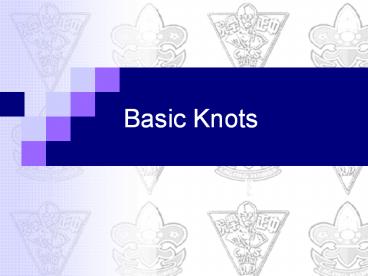Basic Knots PowerPoint PPT Presentation
Title: Basic Knots
1
Basic Knots
2
Overhand Knot
- PROCEDUCE
- Form an overhand loop and insert one end of the
rope into the loop. Then tighten up the knot - Uses
- To stop the end of the rope from fraying
- A series of overhand knots from Quipi, which can
slow down the pace of a man going down a slope
with the aid of a long rope
3
Overhand Knot Picture
4
Figure of Eight Knot
- Uses
- To stop rope from frying
- To wrap packages or bundles
5
Figure Of Eight Knot Picture
6
Square Knot (Reef Knot)
- PROCEDURE
- Hold each end of the knots with both hands
- Form an overhand knot or a loop by placing the
right end over the left the right end entering
from the outer part of the knot going towards the
person - Form a bight, this time, left over right
- Uses
- To close the knot in lashing when making gadgets
- Tie shoe string, gifts, ribbons, bolts, etc
- Bind packages, firewood, etc. together
- To close triangular bandage in first aid
7
Square Knot Picture
8
Sheepshank (Dog Shank)
- Procedure
- Divide a long rope equally into three loops. To
make the loop, follow the procedure for the
clover hitch but add one more loop to make a
total of three loops. - Pull apart the loop at the center passing over
the rope near the center - When the center loop and the hanging ends are
properly pulled, the result is a shortened rope - Uses
- Best used to shorten ropes
- Dogshank is a sheepshank with the eyes seized by
passing the rope ends. The dogshank prevents
sheepshank from slipping
9
Sheep Shank Picture
10
Two Half Hitches
- Procedure
- Loop rope over a post
- Make a clove hitch around the standing part of
the rope - Uses
- To tie the clothesline
- To tie a rope to a tree or pole
- To join two unequal ropes
- The joint is stronger with the use of half hitch
11
Two Half Hitches Picture
12
Sheet bend
- Procedure
- Make a bight in the thicker rope. Bring up the
short end of the thinner rope up through this
bight. - Pass the thinner rope under the bight crossing
the short and first, then behind the bight and up
and over the standing part, across the front of
the bight and under its own standing part.Tighten
by pulling on the standing part. - Uses
- To join two rope ends, especially when they are
not same size.
13
Sheet Bend Picture
14
Timber Hitch
- Procedure
- Make a half hitch.
- Entangle the working part of the rope with half
hitch. - Uses
- To tie a rope to a log or pole that needs to be
pulled. - To start diagonal lashing.
15
Timber Hitch Picture
16
Clove Hitch
- Method A Procedure
- Hold each end with both hands.
- Form a loop with the right end towards you and
the left end away from you. - Let the two loops meet at the center. Insert
finger between the loops. An X is formed when the
two ends meet at the center. - Method B Procedure
- Take one end of the rope in your right hand. With
the left, hold rest of rope across front of pole. - Pass end of rope around in back of pole.
- Bring it around to front of pole. Cross it over
long part making an X. Hold X with left thumb
and forefinger.
17
- Method B Procedure
- Pass rope to the right again, wrapping it around
pole below first turn. - Push rope end under X, going from left to right
so that it comes out between the two turns around
pole. - Pull short end to the right, long end to the
left. - Untie it by pushing both ends towards the center.
- Uses
- To start lashing when making gadgets.
- Tie the clothesline.
- Attach a rope to a tree, pole hands or fingers.
- Bind objects together.
- Tie rope on objects the rope to be used for
mountain climbing, to secure against a tree in
rescuing a drowning person.
18
Clove Hitch Picture
19
Bowline
- Procedure
- Start by forming an overhand loop on the standing
part which is large enough for its purposes. - Take a free end up through the eye, around the
standing part, and right back where it came from. - Uses
- To save a drowning person
- To tie animals
20
Bowline Picture

